Practicing what we preach: Reflections on the
pros and cons of transdisciplinary research
in
Erongarícuaro, Mexico
Practicando lo que predicamos: Reflexiones sobre los pros y los
contras de la
investigación transdisciplinaria en
Erongarícuaro, México
ERIN C. PISCHKEa, LUCÍA PÉREZ VOLKOWb, MAYRA FRAGOSO-MEDINAb, LAURA AGUIRRE FRANCOb
a Postdoctoral researcher, Environmental and Energy Policy, Michigan Technological University, 1400 Townsend Drive, 209 Academic Office
Building, Houghton, MI 49931 USA, epischke@mtu.edu
b Master’s students, Biological Sciences, National Autonomous University of Mexico (UNAM), University City, Mexico City, CDMX, Mexico
DOI: http://dx.doi.org/10.24133/rvespe.v3i1.615
ABSTRACT:
In November 2016, a group of students from the Americas participated
in an Inter-American Institute for Global Change Researchfunded
two-week course organized by professors from the National
Autonomous University of Mexico. The aim was to teach students and
young researchers how to collaborate with non-scientists to conduct
socioecological systems research in a transdisciplinary manner. This
article will review the benefits as well as the challenges to doing so.
It concludes with recommendations that other research teams can
follow when conducting similar research that crosses disciplinary and
international borders.
KEYWORDS:
Transdisciplinarity; Latin America; Mexico; water conservation;
socioecological systems
RESUMEN:
En noviembre 2016, un grupo de estudiantes de las Américas participó
en un curso de dos semanas financiado por el Instituto Interamericano
para la Investigación del Cambio Global y organizado por profesores de
la Universidad Nacional Autónoma de México. El objetivo era enseñar
a los estudiantes y jóvenes investigadores cómo colaborar con nocientíficos
para llevar a cabo investigación de sistemas socioecológicos
de forma transdisciplinaria. El presente artículo revisará los beneficios
y los desafíos para hacerlo. Concluye con recomendaciones que otros
equipos de investigación pueden seguir al realizar investigación similar
que cruza fronteras disciplinarias y geográficas.
PALABRAS CLAVE:
Transdisciplinaridad, América Latina, México, conservación de agua,
sistemas sociecológicos.
Recent trends suggest that conducting transdisciplinary researchin
which academics from different disciplines and non-academics
collaborate on a problem-centered research project (Jahn et al.,
2012)—has several benefits. These benefits include the ability to
approach problems using multiple methods and analytical frameworks
(Kirk-Lawlor & Allred, 2017), the integration of diverse and local
perspectives (Hirsch Hadorn et al., 2006), the capacity to view
problems from both the bottom up and top down and the integration
of non-academic partners (Wickson et al., 2006). Transdisciplinary
approaches often lead to robust project outcomes and direct, contextspecific
solutions to challenging socio-environmental issues (Schmidt
& Pröpper, 2017). For these reasons and more, organizations such as
the Inter-American Institute for Global Change Research-IAI (http://
www.iai.int/) fund researchers and practitioners who are devoted to the
use and promotion of transdisciplinary research. Despite these benefits,
actually conducting transdisciplinary research is challenging. Working
in large, diverse teams—especially those that engage with nonacademics—
can be more time-consuming and frustrating, particularly
when compared to conventional discipline-based projects and courses
(Schmidt & Pröpper, 2017). Universities and funding agencies can also
be hesitant to support these projects and courses due to their relative
nascence (De Torres, 2013; Dieguez et al., 2015). It is critical, then,
for scholars to share experiences so we can collectively work towards
improved processes and outcomes (Jahn et al., 2012).
In this spirit we seek to share the challenges and benefits from our
experience as master’s and doctoral students participating in a twoweek
transdisciplinary short course on conceptualizing the management
of socio-ecological water systems in Michoacán, Mexico. The course
was funded by the IAI, designed and taught by Patricia Balvanera,
Tuyeni Heita Mwampamba, Manuel Maas and Elena Lazos Chavero
of The Institute for Ecosystems and Sustainability Research (IIES) at the National Autonomous University of Mexico (UNAM) and
Tamara
Ortiz Ávila from the community where fieldwork for the course was
conducted. The course was carried out on the UNAM campus in the
city of Morelia and fieldwork was conducted in Erongarícuaro (hereafter
Eronga) in November 2016.
The course involved 17 biological science, agroecology, civil
engineering, economics and policy science students from across
the Americas and five faculty working with five enthusiastic Eronga
community members in charge of forming a Municipal Council for
Sustainable Development citizen organization. The emerging nongovernmental
organization (NGO) had identified problems managing
the municipal water system and were eager to come up with solutions.
The course provided an excellent opportunity to work with a rural
Mexican town and to learn about water management challenges. The
students were tasked with answering: What are the risk perceptions
surrounding the hydro-social cycle of the María Valdez spring (main
potable water source of Eronga), as well as the vulnerabilities and
threats surrounding its use? A critical course outcome was for students
to understand the value of conducting transdisciplinary research as well
as produce solutions for the emerging citizen organization.
Putting aside the brief timeframe, we came up against several design
and implementation challenges that are worth sharing. First, it was
important to the professors that course participants develop and
maintain an interest in multiple scientific disciplines. There were four
course modules (socioecological systems; managing actors and
their actions; vulnerability, poverty and governance; and inter- and
transdisciplinary research tools) which the students were exposed to.
Each of these covered disciplinary perspectives within the topic and the
ways in which the disciplines interact and are intertwined. Professors
discussed the same topics in the field and led students in exercises designed to facilitate hands-on learning about other
disciplines’
methods and collaboration among diverse groups of students. Despite
this, interest was difficult to sustain over two weeks. The majority of the
17 students were from the natural sciences and many were reluctant to
break from the methods in which they were familiar. Moreover, citizens
who were formerly or currently affiliated with academia comprised
the citizen organization’s membership. These factors—students
unwilling to wholeheartedly collaborate across disciplines and a lack
of engagement with the broader public—made it difficult to create a
truly transdisciplinary research design for the class project. Having a
more balanced number of students from various disciplines may have
encouraged students to entertain and use a wider array of methods,
while engagement with several different local NGOs and community
organizations could have increased the diversity of perspectives
involved in the project.
An additional challenge was around engagement with diverse
perspectives. Students were encouraged to interact with community
members during the course, but despite collaborating with a community
organization to outline goals and gain access to the community,
outreach in Eronga and true collaboration was limited to a few staff
of the citizen organization. Therefore, community members who were
experiencing water management issues were not wholly invested in our
research because the request for help from UNAM had come from a
small group of people from the citizen organization.
Finally, Eronga has an indigenous Purépecha population that has
its own unique practices, symbolic values and environmental beliefs
that were unfamiliar to the students and faculty. Most of the citizen
organization staff were non-Purépecha, which further highlighted a
disconnection between the small organization’s interests and those of
the indigenous community members.
While we had many challenges in reconciling indigenous vs. local nonindigenous
vs. academic interests on the ground while working Eronga,
it was a stimulating and worthwhile experience. Students learned from
people in disciplines other than their own and got hands-on experience
while working with the citizen organization. As a group, we collaborated
with a diverse group of people to approach a problem and collectively
design a research strategy that went beyond a purely academic exercise.
Applying theoretical concepts in Eronga allowed students to learn (via
trial and error) how to conduct transdisciplinary research by seeing
a problem from a community organization’s perspective and working
with them to begin to solve it.
The successes and challenges of such a course provide opportunities to
make recommendations for others who wish to conduct transdisciplinary
research and teaching projects. Although there are no silver bullets, we
feel similar endeavors should pay close attention to:
• The facilitation of knowledge-sharing between disciplines in the
classroom as well as in the field. In our case, students only realized
the utility of the course design after having to listen to themed
lectures, reflect on them, write about them in assignments and
then meditate on them in the field. The application of the material
in the field helped the students to make concrete connections
between theory and practice.
• Consensus among all groups involved (students, professors,
community members) during the research design phase,
particularly regarding communication skills. Collaborators should
seek to present group work to all involved audiences to build
a coherent body of collective knowledge. A project can sustain
continuity better if everyone can anticipate what to expect as the
project moves along.
• The amount of time actually needed for data collection and
analysis. Conducting transdisciplinary research is often more
time-consuming than other types of research. Faculty, students
and citizen organization staff members worked daily to design
our methodology, meet with community members and collect
data. After students dispersed once the course ended, it
became more difficult to interact with community members
from Eronga and find common meeting times when small
groups could work on writing the final report to present to the
citizen organization.
Several months after the course ended, students delivered a 98-page
report to the professors and citizen organization which outlined their
findings about the perceived threats to the María Valdez spring’s hydrosocial
cycle. The report covers the social organization of Eronga and
surrounding communities, management of the environment, including a
focus on water management, as well as a review of the cultural makeup
of the study location. It offers recommendations to the community and
citizen organization for how to bolster integrated management of the
local hydro-social cycle. In addition to the written report, a small group
of students and one professor returned to Eronga to present findings to
the general public and field questions. Some students and professors
continue to collaborate while others have kept in touch with the citizen
organization.
In conclusion, international problems like climate change have no one
cause and no single solution. Solutions must come from many angles,
sources and perspectives. Our experience with an academic course
that joined engineering, natural and social sciences with a citizen
organization to transdisciplinarily study the hydro-social cycle in a rural
Mexican community is one example of such an approach to a local
community problem. Successful interdisciplinary and transdisciplinary
teamwork is, however, in and of itself also a wicked problem (Norris et al., 2016). Identifying and understanding the challenges that
transdisciplinary research teams face when conducting research
abroad can suggest ways to overcome such barriers. A multi-pronged
approach tackles problems from various angles to, in a sense, make
the problem smaller and inform future research.
REFERENCES
De Torres, M.F. (2013). Clima en Colectivo/Reflexiones Sobre la
Interdisciplina. In: Picasso, V., Cruz, G., Astigarraga, L., Terra, R. (eds),
Cambio y Variabilidad Climática: Respuestas Interdisciplinarias. Espacio
Interdisciplinario, Universidad de la Republica: Montevideo, 132pp.
Dieguez, F., Toranza, C., Caorsi, M.L., García Cartagena, M. (2015).
Construyendo Interdisciplina en Torno al Cambio y la Variabilidad
Climática. In: Astigarraga, L, Terra, R, Cruz, G, Picasso, V. (eds.), Centro
Interdisciplinario de Respuesta al Cambio y Variabilidad Climática:
Vínculos Ciencia-Política y Ciencia-Sociedad. Espacio Interdisciplinario,
Universidad de la Republica: Montevideo, 142pp.
Hirsch Hadorn, G., Bradley, D., Pohl, C., Rist, S. & Wiesmann, U. (2006)
Implications of transdisciplinarity for sustainability research. Ecol. Econ.,
60, 119-128.
Jahn, T., Bergmann, M. and Keil, F. (2012) Transdisciplinarity: Between
Mainstreaming and Marginalization. Ecological Economics, 79, 1-10.
Kirk-Lawlor, N. and Allred, S. (2017). Group Development and Integration
in a Cross-Disciplinary and Intercultural Research Team. Environmental
management, 59(4), 665-683.
Norris, P., O’Rourke, M., Mayer, A., and Halvorsen, K.E. (2016). Doubling
Down: Transdisciplinary Research Team Formation as a Wicked Problem.
Landscape and Urban Planning, 154, 115-122.
Schmidt, L. and Pröpper, M. (2017). Transdisciplinarity as a Real-World
Challenge: A Case Study on a North–South Collaboration. Sustainability
Science, 12(3), 365-379.
Wickson, F., Carew, A. L., & Russell, A. W. (2006). Transdisciplinary research:
characteristics, quandaries and quality. Futures, 38(9), 1046-1059.
AUTHOR BIOGRAPHIES:
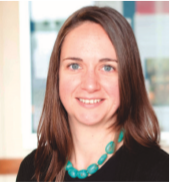 Erin C. Pischke is a post-doctoral researcher in the
Environmental and Energy Policy program at Michigan
Technological University. She conducts energy-related
research in Mexico and collaborates with others on large
international Inter-American Institute for Global Change
Research projects.
Erin C. Pischke is a post-doctoral researcher in the
Environmental and Energy Policy program at Michigan
Technological University. She conducts energy-related
research in Mexico and collaborates with others on large
international Inter-American Institute for Global Change
Research projects.
 Lucía Pérez Volkow is a biology student from the
National Autonomous University of Mexico (UNAM). Her
research focuses on studying traditional management of
charcoal in Mexican oak forests from a socioecological
perspective.
Lucía Pérez Volkow is a biology student from the
National Autonomous University of Mexico (UNAM). Her
research focuses on studying traditional management of
charcoal in Mexican oak forests from a socioecological
perspective.
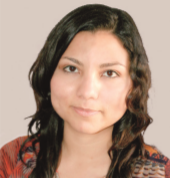 Mayra Fragoso-Medina is a master’s student in
biological sciences at UNAM and Sevilla University
(US) in Spain. Her research focuses on ecology and
restoration of fields invaded by Pteridium sp. in the
Lacandon tropical forest.
Mayra Fragoso-Medina is a master’s student in
biological sciences at UNAM and Sevilla University
(US) in Spain. Her research focuses on ecology and
restoration of fields invaded by Pteridium sp. in the
Lacandon tropical forest.
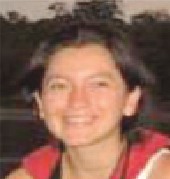 Laura Aguirre Franco is a biologist for the National
University of Colombia and master’s student in biological
sciences at UNAM. Her research focuses on the ecology,
management and restoration of tropical wetlands. She
is interested in using inter- and transdisciplinarity as
conceptual and methodological frameworks in her work.
Laura Aguirre Franco is a biologist for the National
University of Colombia and master’s student in biological
sciences at UNAM. Her research focuses on the ecology,
management and restoration of tropical wetlands. She
is interested in using inter- and transdisciplinarity as
conceptual and methodological frameworks in her work.
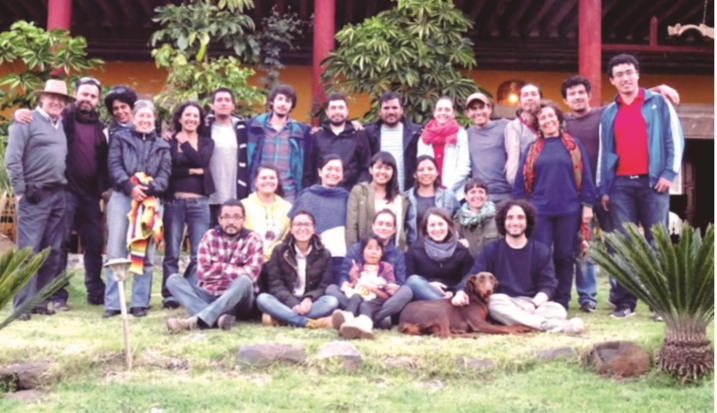
Students, faculty and community members in Erongarícuaro, Mexico
(Credit: Dr. Manuel Maass, UNAM)
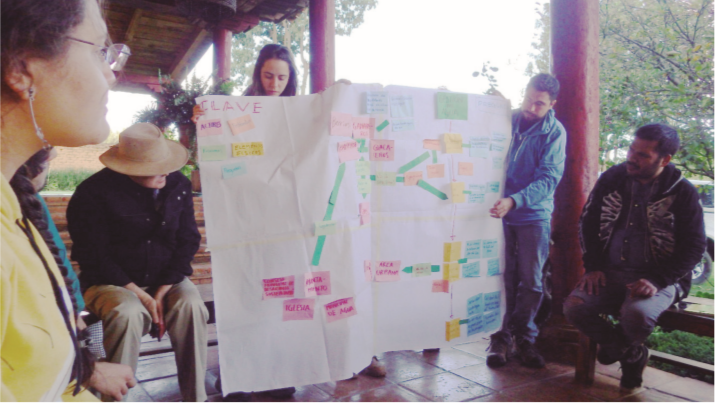
Students and faculty discuss a concept map of the socioecological system in Eronga
(Credit: Erin C. Pischke)
 Erin C. Pischke is a post-doctoral researcher in the
Environmental and Energy Policy program at Michigan
Technological University. She conducts energy-related
research in Mexico and collaborates with others on large
international Inter-American Institute for Global Change
Research projects.
Erin C. Pischke is a post-doctoral researcher in the
Environmental and Energy Policy program at Michigan
Technological University. She conducts energy-related
research in Mexico and collaborates with others on large
international Inter-American Institute for Global Change
Research projects. Lucía Pérez Volkow is a biology student from the
National Autonomous University of Mexico (UNAM). Her
research focuses on studying traditional management of
charcoal in Mexican oak forests from a socioecological
perspective.
Lucía Pérez Volkow is a biology student from the
National Autonomous University of Mexico (UNAM). Her
research focuses on studying traditional management of
charcoal in Mexican oak forests from a socioecological
perspective. Mayra Fragoso-Medina is a master’s student in
biological sciences at UNAM and Sevilla University
(US) in Spain. Her research focuses on ecology and
restoration of fields invaded by Pteridium sp. in the
Lacandon tropical forest.
Mayra Fragoso-Medina is a master’s student in
biological sciences at UNAM and Sevilla University
(US) in Spain. Her research focuses on ecology and
restoration of fields invaded by Pteridium sp. in the
Lacandon tropical forest. Laura Aguirre Franco is a biologist for the National
University of Colombia and master’s student in biological
sciences at UNAM. Her research focuses on the ecology,
management and restoration of tropical wetlands. She
is interested in using inter- and transdisciplinarity as
conceptual and methodological frameworks in her work.
Laura Aguirre Franco is a biologist for the National
University of Colombia and master’s student in biological
sciences at UNAM. Her research focuses on the ecology,
management and restoration of tropical wetlands. She
is interested in using inter- and transdisciplinarity as
conceptual and methodological frameworks in her work.
